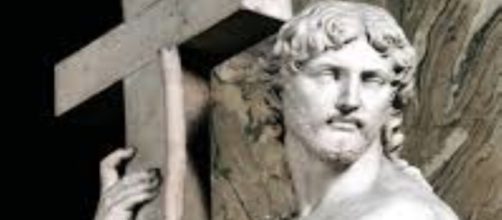“Location, location, location,” the rule of real estate that rates identical houses differently depending on their neighborhood, can be applied to Michelangelo's marble sculpture “The Risen Christ.” There are two of these, one in Rome and the other in London. Both show Christ in the nude, but the male member on the figure seen at the church of Santa Maria sopra Minerva is veiled in metal while it’s not in the figure at the National Gallery. Michelangelo sculpted both in 1521, but after he died the church added the jockstrap-like cover, which is still in place and has the unfortunate effect of directing ones’ attention to that area of the body.
Making a point
The unshielded version is on loan to Britain from San Vincenzo Monastery in Bassano Romano, where it stood unknown and unacknowledged until a decade ago when it was identified as a lost work by Michelangelo. Apparently as he was finishing the carving, he spotted a flaw in the stone and turned to another block of stone to start again. Unnamed artists finished off the cast away version. In either case, picturing Christ without clothes was not unusual for this artist. One look at his Sistine Chapel ceiling painting makes that clear. But not all Renaissance artists felt as free. Two years after Michelangelo carved “The Risen Christ” Titian draped the Christ figure in his painting “Noli Me Tangere” and Raphael robed the figure in “The Transfiguration.” Caravaggio went so far as to paint the risen body fully clothed in his “Supper at Emmaus.” Michelangelo, who was deeply religious, sought to underscore Christ’s triumphant return in all its glory.
Even the wounds suffered at the Crucifixion are included.
Still not getting it
The sculptor also used nudity for lofty reasons in his paintings. For “The Last Judgment,” a fresco rendered on the altar wall of the Sistine Chapel, he stripped every figure, from saints to Christ as if to strip their station in life. Not unexpectedly, there were complaints. Biagio da Cesena, who worked for the Pope, said it was “disgraceful” to expose the nakedness of saints and that the painting was better suited to a tavern than a papal chapel. After Michelangelo died, the bared anatomy was painted over and only restored in the 1990s. And as recently as last summer, residents of St. Petersburg Russia complained about the nudity of a 16-foot tall coy of his “David” telling the local press how outrageous it was to see a man “without any trousers” in the center of the city.
Meanwhile, back in the Vatican Michelangelo continues to be misunderstood. In 2012, a statement was issued requesting that “David” be covered: “We must stop shielding ourselves behind a culture of art and forsaking religion.” Wherever the sculptor is now, he must be scratching his head.

